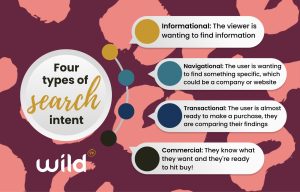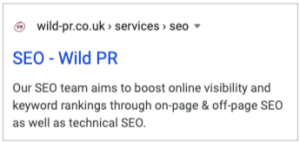Contents:
1. Introduction
2. Keyword research
3. Metadata
4. Optimising images
5. Alt & title tags
6. Internal linking
When optimising your web pages, there are plenty of things to consider and put into play.
Optimising your pages to meet guidelines, rank for keywords, and get the organic traffic you’ve been looking for can be tricky, but the Wild PR team have hit the nail on the head with a checklist on how to get your page number one in the SERPs!
Dig in with keyword research
Keyword research plays the most significant part in writing content; how do you know what people are searching for if you’ve not done the research?
There are tonnes of wild tools out there that will help you find the keywords/questions you need to be including in your content; here are a few that we use mostly:
– SE Ranking: this tool provides a good summary of keywords you should be looking for, related terms and what pages are currently ranking for that particular keyword; this allows you to see what competitors you may be up against
– SEMrush: this tool gives you extensive information for any keyword you put into the search bar; SEMrush tracks keywords every minute of every day, allowing you to have the most up-to-date information you require.
– Ahrefs: this gives you the best free keyword research tool overall with the Keyword explorer tool; you can search any keyword you choose and see its monthly volume, difficulty, and organic clickthrough rate
- – Google Trends: this is a free tool that analyses Google searches to provide trending topics in real-time, identify seasonal peaks of interest, monitor competitors and more.
Once you’ve chosen which tool to use, you’re ready to hit the ground running with your keyword research.
When carrying out your keyword research, ensure that the search volume of chosen keywords is around 30 or higher; the search volume is per month, so the more searches, the better. Also, think about the types of keywords and why people may be searching for them. The four types of search intent include informational, navigational, transactional and commercial!

Update your Metadata
The next vital step is ensuring that your metadata is the best; this includes the H1 (header), title tag and meta description; this content will appear in the search results, known as the SERP (search engine results page).

When writing metadata, the text needs to reflect what that page is about, whether it’s the homepage or a category page; it needs to have an exact description so the search engine and the viewer can see that the page is relevant to their search. What will happen if your meta description isn’t relevant to the search? No clicks.
Character counts for metadata
– Meta descriptions should be no more than 160 characters and no less than 50
– Meta titles should be around 50 – 75 characters.
Let’s move on to optimising images!
Adding images to your blog content and web pages makes the content more appealing to the user. Relevant images may even back up your message and improve your ranking within Google image searches, but only when ensuring technical support such as alt attributes are in place!
Alt text and titles strengthen the message for Google crawls and improve the accessibility of your website and content. But what is the difference between an alt tag and a title tag?
An alt tag gives an image a description that search engines and screen readers can see and hear. A title tag explains what the image is within the ‘src’ attribute.
Also, don’t forget about the size of your image! Resizing your images may seem obvious, but more often than not, reducing the image file size is forgotten. Your image file size will impact your page’s speed. Slow page speed equals a high bounce rate, and who wants to wait around? Anything bigger than 20 megabytes in size can dramatically impact your website speed, so you are better using smaller images (up to 2 megabytes in size) in most cases.
Don’t forget internal linking
Internal linking plays a HUGE part in how Google or any search engine bot crawls your website.
Think of internal linking like how you would use a bridge; for a bot to get from one place to another, it will need a bridge, which we all know as a link. Once that bridge isn’t in place, the crawling will stop, and more bridges (links) result in more pages the bot can access!
One thing to remember when implementing internal linking on a page, a bot can only really crawl, on average, 100 links per page; most of us won’t have pages that will require 100 links, but if you do, just be mindful of that.